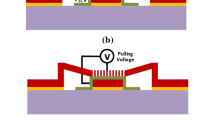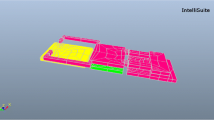Abstract
An improved electromechanical model of the RF MEMS (radio frequency microelectromechanical systems) switches is introduced, in which the effects of intrinsic residual stress from fabrication processes, axial stress due to stretching of beam, and fringing field are taken into account. Four dimensionless numbers are derived from the governing equation of the developed model. A semi-analytical method is developed to calculate the behavior of the RF MEMS switches. Subsequently the influence of the material and geometry parameters on the behavior of the structure is analyzed and compared, and the corresponding analysis with the dimensionless numbers is conducted too. The quantitative relationship between the presented parameters and the critical pull-in voltage is obtained, and the relative importance of those parameters is given.
Similar content being viewed by others
References
Yao JJ. Topical review: RF MEMS from a device perspective.J Micromech Microeng, 2000, 10: R9-R38
Nguyen CT. Microelectromechanical devices for wire-less communications. In: IEEE MEMS'98, Heidelberg, Germany, 1998. 1–7
Feng ZP, Zhang HT, Zhang WG, et al. MEMS-based variable capacitor for millimeter-wave applications. In: Proceedings of Solid-State Sensor and Actuator Workshop, Hilton Head Island, South Carolina, 2000. 255–258
Elders J, Spiering V, Walsh S. Microsystems Technology (MST) and MEMS applications: an overview.Microelectromechanical Systems: Technology and Applications (MRS Bulletin), 2001, 26 (4): 312–317
Peterson KE. Micromechanical membranes switches on silicon.IBM J Res Dev, 1979, 23: 376–385
Zhang LX, Zhao YP. Electromechanical model of RF MEMS switches. Microsystem Technologies, 2003, 9(6–7): 420–426
Osterberg PM. Electrostatically actuated micromechanical test structures for material property measurement. [Ph D Dissertation], MIT, Cambridge, MA, 1995
Huang JM, Liew KM, Wong CH, et al. Mechanical design and optimization of capacitive micromachined switch.Sensors and Actuators, 2001, A(93): 273–285
Temoshenko S. Theory of plates and shells. McGraw-Hill, Inc, 1987
Qian J, Liu C, Zhang DC, et al. Residual stress in micro-electro-mechanical systems.Journal of Mechanical Strength, Special Issue on MEMS, 2001, 23(4): 393–401 (in Chinese)
Pauleau Y. Generation and evolution of residual stress in physical vapour-deposited thin films.Vaccum, 2001, 61: 175–181
Choi B, Lovell EG. Improved analysis of microbeams under mechanical and electrostatic loads.J Micromech Microeng, 1997, 7: 24–29
Gupta RK. Electrostatic pull-in test structure design for in-situ mechanical property measurements of Micro-Electro-Mechanical Systems (MEMS). [Ph d Dissertation], the Massachusetts Institute of Technology, USA, 1997
Author information
Authors and Affiliations
Additional information
The project supported by the National Natural Science Foundation of China, the Chinese Academy of Sciences, the RGC/NSFC Joint Research Scheme (N-HKUST 601/01) and the Joint Laboratory of Microsystems
Rights and permissions
About this article
Cite this article
Lixian, Z., Tongxi, Y. & Yapu, Z. Numerical analysis of theoretical model of the RF MEMS switches. Acta Mech Sin 20, 178–184 (2004). https://doi.org/10.1007/BF02484263
Received:
Issue Date:
DOI: https://doi.org/10.1007/BF02484263




